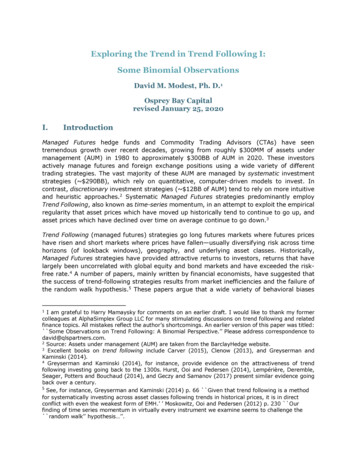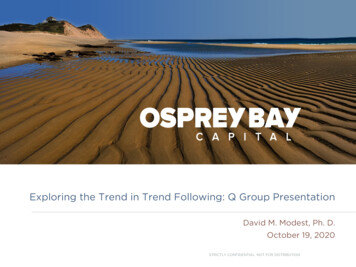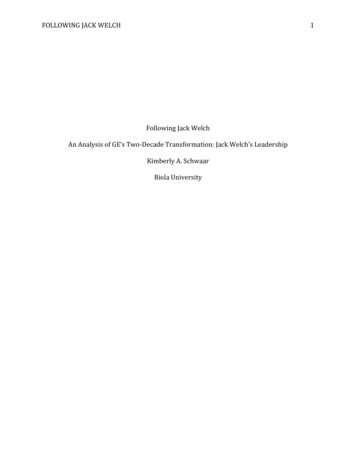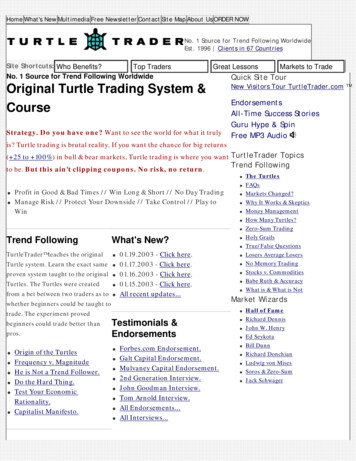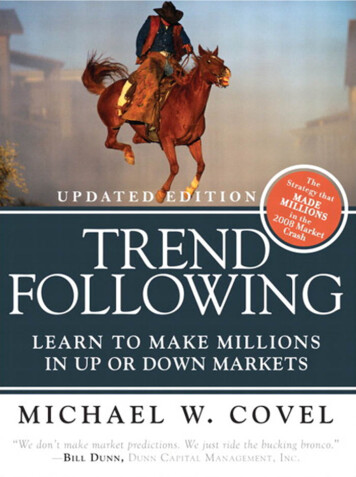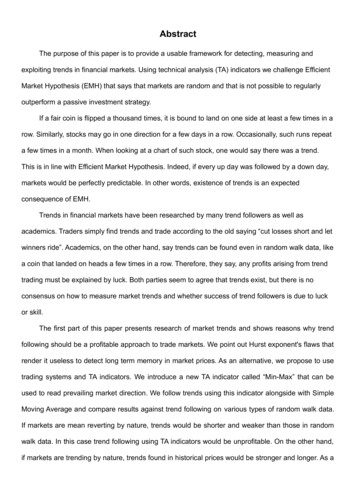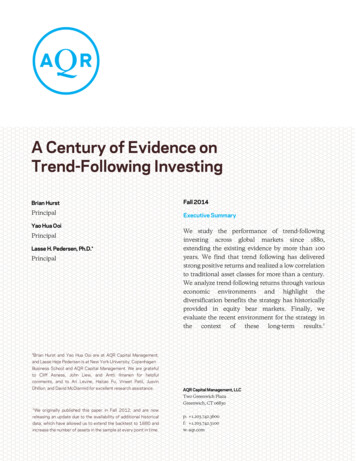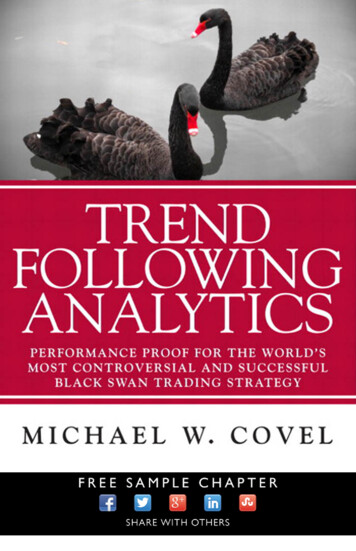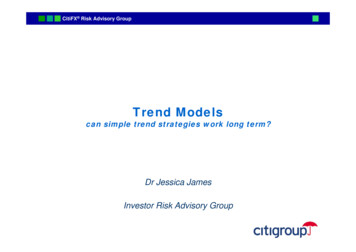
Transcription
CitiFX Risk Advisory GroupTrend Modelscan simple trend strategies work long term?Dr Jessica JamesInvestor Risk Advisory Group
CitiFX Risk Advisory GroupOverview 2Trend models – general overviewIn- and out-of-sample testingTrend model enhancements
CitiFX Risk Advisory GroupTrend models overview
CitiFX Risk Advisory GroupTrend is popular 485% of CTA returns are explained by simple trend followingThe figure rises to almost 100% when carry and option trading are includedThey are without doubt the most popular systematic rule-based strategies usedby overlay managers and currency alpha fundsThey may be backtested relatively easily
CitiFX Risk Advisory GroupTrend models The idea of a trend is intimately connected with that of momentum – if acurrency moves in one direction in one period, it is likely to continue thatdirection in the nextHowever, there will be reversals within larger trends, and the key to successfultrend following is to discover when a trend starts and ends, and not be taken inby false signalsMoving average models are historically very successful at capturing trends andthey have many different variations simple MAmultiple MAexponentialGarchfade in/outWe use the simplest possible – a simple single MA – for research purposes. further complexity may be added if a principle is established5
CitiFX Risk Advisory GroupHistorical returns to trend models 6Historically, long term trends are displayed in currency pairs which are theexchange rates between disparate economies – USD/JPY, EUR/USD etc.Interestingly, those pairs which do display a marked tendency to trend all havetheir optimal moving average at about 70 daysThose currencies which historically have not trended are the pairs which are theexchange rates between closely linked economies – EUR/CHF, GBP/USD etc.The majority of trend models give very similar results
CitiFX Risk Advisory GroupTrending or not? 7We sought to establish which currencies ‘trend’ or not by looking at the resultsof the simplest possible trend following strategy – that of a single movingaverageBy buying when the rate was above a simple arithmetic moving average, andselling when it was below, we obtained a P/L curve for the trading strategysince the start of the data set, in 1992We looked at every length of moving average strategy from 5 to 130 daysWe use USD/JPY and USD/CAD as opposite examplesForwards are not included but tests with full MTM calculations indicate that theymake little difference, even to USD/JPY
CitiFX Risk Advisory GroupTwo very different currencies The behaviour of the two currencies is utterly differentUSD/JPY makes money and has a positive IR for almost any length of movingaverage So strong is the trending behaviour of the JPY that similar all-encompassing positiveresults are obtained for most of its crosses. USD/CAD stubbornly refuses to rise above zero under any circumstancesIt is not difficult to draw the conclusion that USD/JPY trends and USD/CADdoes notAnnual Returns and IR as a function of moving averagelength for USD/JPY15%10%0.45%0.20%0.0-0.2020406080100120Days in moving averageInformation RatioAnnual Return-5%140Inform ation Ratio0.60.4Annual returnInform ation Ratio0.88Annual Returns and IR as a function of moving averagelength for USD/CAD0.20.0-0.2-0.4-0.6-0.8020406080100120Days in moving averageInformation RatioAnnual Return10%8%6%4%2%0%-2%-4%-6%140Annual return
CitiFX Risk Advisory GroupMore 6080100120Days in moving averageInformation Ratio9Annual Return10%8%6%4%2%0%-2%-4%-6%140Information Ratio0.440100120Annual ReturnAnnual Returns and IR as a function of moving averagelength for EUR/JPYAnnual returnInformation Ratio0.62080Information RatioAnnual ReturnAnnual Returns and IR as a function of moving averagelength for EUR/USD060Days in moving averageDays in moving averageInformation .20.12%8%4%0%0.0-0.1020406080100120Days in moving averageInformation RatioAnnual Return-2%140Annual return00.4Inform ation Ratio10%Annual returnInformation Ratio0.40.2Annual returnAnnual Returns and IR as a function of moving averagelength for USD/AUDAnnual Returns and IR as a function of moving averagelength for USD/CHFNote that the pastabout 40 daysthere isextraordinarystability ofperformance withrespect to themoving average
CitiFX Risk Advisory GroupStability of returns and IR We tested out the stability of the strategy with respect to the number of days inthe moving averageWe find that in fact there is a large range of moving averages which deliversimilar returns for the average portfolioDate100 day returns40 day returns1080 day returns20 day returns60 day 20%15%10%5%0%-5%88returns in % faceCumulative returns for various moving average strategies,for the average portfolio
CitiFX Risk Advisory GroupThe ‘best’ moving average It is interesting to find the ‘best’ moving average obviously this is an optimisation, but only of a single parameter 11Accordingly we repeated the analysis with finer granularity, creating returnsand information ratios for moving averages between 20 and 100 days with‘steps’ of 5 daysThe following graphs reveal the optimal region.
CitiFX Risk Advisory GroupOptimal region for annual returnVariation of Annual Return with days in moving avarage10.00%USD/JPY8.00%USD/CHFAnnual -2.00%Average-4.00%Days in moving average12807570656055504540353025200.00%There is a best‘region’ around 70days but in generalresults are notsensitive to thenumber of daysThere is a clearpicture of thedegree of trendactivity in eachcurrency
CitiFX Risk Advisory GroupOptimal region for information ratioThe best ‘region’ isthe same, as is thelack of sensitivity tothe moving averageVariation of Information Ratio with days in moving avarage1.00USD/JPY0.80Annual .20CHF/JPYUSD/AUD0.00USD/CAD20 25 30 35 40 45 50 55 60 65 70 75 80 85 90 95 100-0.20GBP/USD-0.40GBP/CHFAverage-0.60Days in moving average13EUR/CHF
CitiFX Risk Advisory GroupSingle moving average vs multiple movingaverage Strategies with multiple moving averages are popular in the FX modelling world.This is for several reasons. (1) As a trend establishes itself then the moving averages will gradually cross over the actual rate and each other, the shorter followed by the longer, until all of them liebelow the actual rate. There is thus the possibility to ‘fade in’ and gradually takeincreasing positions as the trend becomes stronger(2) By optimising the fade levels and the numbers of days in the moving averages,backtested returns can be greatly improved over simpler models(3)For advisory rather than strict model following approaches, there are a number ofdifferent strength signals for trendsWhile (1) has some merits, (2) has to be regarded with caution because overoptimisation is very easy to achieve with this method In general, if a currency is not tradable with a simple single moving average, then 14‘improving’ its backtested performance by optimising additional moving averages isunlikely to improve returns in the futureOn the other hand, a currency which already works reasonably well with a single MAmight have some robust improvements from the introduction of another. Some kind ofplateau optimisation should be performed to reduce the chances of over-optimisation.
CitiFX Risk Advisory GroupHistorical returns to 70 day single movingaverage modelCurrency PairIRAnnual ReturnUSD/JPY USD/CHF USD/AUD USD/CAD EUR/USD EUR/JPY EUR/GBP EUR/CHF GBP/USD GBP/JPY GBP/CHF .03%1.83%-0.91%-1.40%3.43%-0.20%3.56%Cumulative returns of 70 day MA strategy140%USD/JPYReturns in % n general returns are positivethough a number of pairsdisplay little trending activityRecent results look less good –but then the same featureshave occurred in the past
CitiFX Risk Advisory Group2004 70 day single moving average modelIRAnnual ReturnUSD/JPY USD/CHF USD/AUD USD/CAD EUR/USD EUR/JPY EUR/GBP EUR/CHF GBP/USD GBP/JPY GBP/CHF .195-0.468-0.073-0.069-0.589-7.07%-7.49% .52%-3.55%Cumulative returns of 70 day MA Returns in % face15%GBP/CHFCHF/JPYThis last year’s results havebeen particularly horrible, withonly a few currencies showinga positive returnThe latest 6weeks or sohowever have been muchbetter, seeing the returns oftrends to the markets after theUS elections were complete
CitiFX Risk Advisory GroupIn- and out-of-sample testsThe results we find are surprising
CitiFX Risk Advisory GroupTest methodology – 2-stage approach Initially, we select data periods of different lengths and find the best movingaverages, over a variety of currency pairs. We examine cases from one to four moving averages. We wish to see what improvement is found in-sample by more moving averages At some point improvement may be purely due to noise fitting, but we would hope tobe able to detect this point by looking at the magnitude of changes in IR. Next, we find the optimal moving averages for various in-sample periods, andapply them to subsequent out-of-sample periods This will tell us whether the best moving averages are useful for forecasting purposes We also hope to gain information about the time period necessary for such 18information to emergeAdditionally, we may learn how many moving averages may usefully be extractedfrom different data periods and applied to future periods. It is entirely feasible thatone could extract 2 useful parameters from a data set of a given length but not 3. Inthis case we would expect to see in- and out-of-sample results show the smallestdifference at the ‘right’ number of parameters
CitiFX Risk Advisory GroupMA model details We use the simplest moving average crossover strategyEach average is equally weightedSpot above 3 movingaverages: 100%19Spot above 2averages: 33%movingSpot above 1average: -33%movingSpot above 0average: -100%moving
CitiFX Risk Advisory GroupIn-sample optimised results1MA2MA3MA4MA20Lengthof .2100.2100.2700.3470.440
CitiFX Risk Advisory GroupIn-sample results Even in-sample, there is very little to be gained from moving to more than onemoving averageThe results in the 4MA section are barely better than those in the 1MA sectionThis begs the question, why do users ever have more than one movingaverage? Possibly multiple strategies are easier to trade in that positions are built up gradually 21rather than put on all at once.There seems no reason to do with performance which would lead us to use manyrather than one.The second feature of the table worth discussing is that universally, the IRs arebetter for the shorter data periodsThis finding is consistent with a lack of stationarity in moving average models
CitiFX Risk Advisory GroupOut-of-sample testing1MA2MA3MA4MA22Lengthof 400.080We expect to see adecrease in IR forthe out-of-sampletests, due toinevitable noisefitting.What we aresearching for is thenumber of fittedparameters whichminimises thedecrease between inand out-of-sampletests.
CitiFX Risk Advisory GroupOut-of-sample results Unfortunately, it is not possible to draw any firm conclusions about the idealnumber of parameters in a trend modelIt can be said that nothing performs significantly better out-of-sample than the1MA modelThere are only two currency pairs for which the out-of-sample results aresignificantly positive USD/JPY yields good information ratios both in and out-of-sample EUR/USD results are also all positive for out of sample periods, though not quite ashigh 23The resul
CitiFX Risk Advisory Group 5 Trend models The idea of a trend is intimately connected with that of momentum – if a currency moves in one direction in one period, it is likely to continue that direction in the next However, there will be reversals within larger trends, and the key to successful trend following is to discover when a trend starts and ends, and not be taken in
